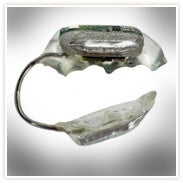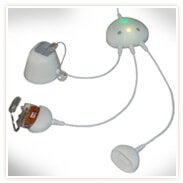Single sided deafness affects around 200 out of every million people the world over. The loss of stereo hearing can prove dangerous when crossing the street, or other mobile environments. Sonitus Medical has developed a new device, SoundBite, that uses the natural conduction of teeth and bone to transmit sound to the inner ear even after the outer and middle ear are damaged.

SoundBite detects noise using a microphone placed in the ear connected to a transmitter in a behind-the-ear (BTE) device. The BTE transmits to an in-the-mouth (ITM) device that sends small sound waves through the jaw to the cochlea. There is no surgery needed, and both the BTE and ITM are easily removed to be charged inductively. Sonitus Medical is still preparing the SoundBite for eventual FDA trials for single sided, and (eventually) other forms of deafness. Check out more photos after the break.
There are other hearing aid devices that utilize bone conduction. Most, however, use a titanium pin drilled into the jaw bone (or skull) to transmit sound to the cochlea. SoundBite seems to be the first non-surgical, non-invasive, easily removable device. While they are likely years from retail production, Sonitus Medical plans on having SoundBite ITMs fitted to each individual’s upper back teeth and fabricated fairly quickly (1 to 2 weeks). A complete system is planned to include two ITMs, 1 BTE, and a charger. In the wider world of cochlear implants, SoundBite may only be fit for relatively specialized use. Still, the ability to easily upgrade or replace individual components makes the device competitive. A similar device could be adapted to provide audio for a personalized augmented reality system. Perhaps the Bluetooth headset of the future will involve actual teeth.



[photo credits: Sonitus Medical]


